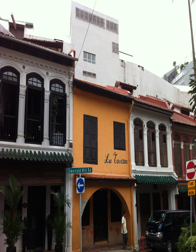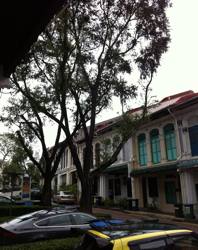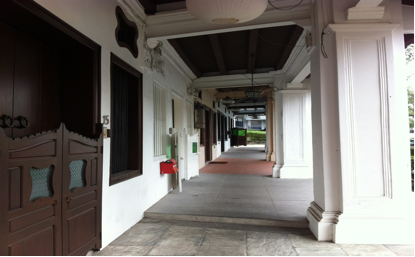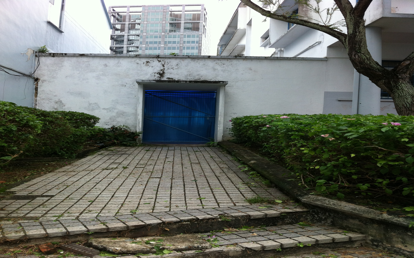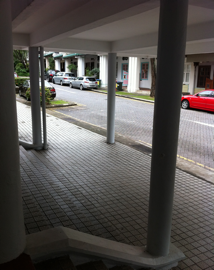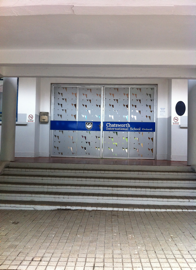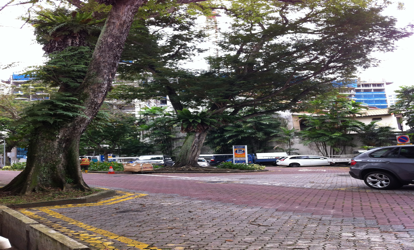by Chew Yi Wei
There is an old place, ensconced snugly and discreetly in a pocket of Orchard Road that I will always return to, no matter how long ago it has been since I left. Like going home, this return journey is irrepressible and gravitating. This place is none other than Emerald Hill – the grand old dame which is today a site of real estate prestige, a regular haunt for merry-makers and tourists; the regal queen which has been mythologized in plays like Emily of Emerald Hill, a place where stories originate and perpetuate; the glowing gem that has been iconized in the annals of Singapore’s history and architectural heritage.
Today I make my way there on foot; the surest, most contemplative means of travel where one is able to absorb the quintessence of her surrounding environment, its sights, sounds, texture, gaining as it were an emotive resonance through perambulatory pleasure.
Emerald hill is flanked on both sides by old Peranakan shop houses. During the late 80s and early 90s, I used to walk up those dusty corridors, five days a week. Many other girls like me walked the same path – some in the morning, others in the afternoon and in the evening, back down into Orchard Road. As I enter Emerald Hill, those years like sad, friendly ghosts greet me quaintly, with a sigh almost. As my pace gathers unhurried, measured ground, I find myself sinking into a sort of time warp. The hustle and bustle of Orchard Road fades away and a strange quiet takes over. Just a few steps into Emerald Hill and the sounds of passing traffic turn into a muffle, ushering in a more somber, plaintive sonic environment. Traces of what used to be start to reappear, forming a spectral layer over the solidness of the present. It is not that things look particularly different; more insidiously, they only have the semblance of difference. Because time has passed, I expect things to look older, but they do not. Conservation efforts merely simulate the past, giving us only a pretty, charming but ersatz image of it. Conservation is nostalgia with a lost cause. Can we not retain the past by leaving it alone? In a bid to keep the past, we sap the life out of it.
The shop houses do not look the least bit aged; on the contrary, like the rest of Orchard Road, they have not been spared the artificiality of anti-aging mechanisms. The old flapping wooden doors have now been given a new, polished glaze. Gone are the creaky, flaking wooden doors that once graced the corridor of this long line of shop houses.
What strikes me amidst this ambivalent familiarity is however the old antique shop with its red exterior walls. For six and a half years (1988-1994), I walked past the shop not bothering even once to set foot in. To my then immature mind, antiques were meant only for people who had an excessive abundance of time on their hands to waste away. At least I am now able to appreciate them as delicate evidences of the past. Today I decide that I need to break that long spell of un-entering, to finally make my first foray into one of the places in Emerald Hill that has been left determinedly untouched. It seems even quieter inside the shop. Nothing stirs. The two old men, proprietors of the shop, have probably been there since the beginning of its time. They watch me furtively. Only their eyes move. Not a word is said. I feel their scorching, uncongenial gaze on me as I thread carefully around the cluttered shop. Like resigned relics they sit, unmoving, not bothering an iota if I would even have the slightest intention of making a purchase. If these two old men were collectors of antiques themselves, they would have also added the years to their collection. And as such they remain, to this day, the precious few living voices still able to tell the story of Emerald Hill.
Hand-carved wooden fishermen in straw hats stand uncomplaining in the glass display cabinets. Little China boxes, intricately hand-painted sit reticently on rose-wood tables layered with dust, concealing years of unopened secrets, eternally lost to me. Enameled vases, vessels and cookware placed securely on long sideboards speak of a dynasty immortalized in a glossy finish; the furnace they had to go through to attain that end embellish them with a dignified resonance and resilience that rebels against the passing of time.
At this moment, my sight dalliances with my olfactory senses and I conjure the words of William Carlos Williams who says with defiant irony in his poem “Smell!”: “Oh strong rigged and deeply hollowed / nose of mine! What will you not be smelling?” (92)1 And indeed, what could I not smell in this little curio-city shop! What antiquated odors would not tickle my nostrils and gently project me back to those days when I trudged past it! It is unmistakable, and as Edward Thomas would intone: “It is enough / To smell” (79)2! That dust-covered, mildewed, musty, fusty ol(d)-factory effusion; the smell of younger days, the odd scent of memory. I know it instinctively and at once, I see my eleven year old self walking past the shop in my blue uniform and canvas shoes on a hot mid-morning, glancing at a huge vase standing at its entrance and wondering who in the right mind would ever buy it. Then the smell greets me and I am one step closer to the start of another school day.
If one could demarcate an area on his or her mnemonic map, then the invisible arms of smell would inevitably figure as some sort of boundary, a signpost to single out the particularity of that place in question. Some smells only belong to some places. One smell can sometimes only belong to one place. I am glad that I never lost the memory of this smell. Its distinctiveness, not quite redolent though it is, represents a part of my life that I can never return to; the encapsulation of my school days in Emerald Hill enfolded and gilded into one permeating, intimate smell-scape.
I step out of the shop. The two old men show no visible sign of reacting. Before I run off, I turn to its signboard in a bid to commit the name of the shop to memory. What is within closest reach is always furthest from us: it never occurred to me to find out what the shop was called when I had the opportunity to walk past it everyday. So today, I confront my long-time apathy: the One Price Store, it is named, almost like an epithet. A very clever way of telling its customers that it isn’t quite tolerant of bargain hunters. One would have thought the shop deserving of a more austere name perhaps. Despite the forthrightness in appellation, the shop survives. I inhale its signature staleness for the last time and walk on.
A few doors down and I’m back at the old school. The side entrance – an old metal gate – once open morning, noon and evening is now perpetually closed, and sealed. What used to be a metal gate with square grids is today sealed with a blue plastic sheet. To my delight however, the wall framing the gate has yet to lose its cracks and stains; a dignified oldness remains, reticently retaining a sense of connection and continuity to the past, my past.
Some steps away is the bus bay, where buses and vans used to park bumper to bumper in the afternoons and evenings, first alighting a hoard of girls then awaiting another hoard to board once the bell rings. As I stand at the deserted bus bay, I realize now just how short the length of the area is. Places are polymorphous; their dimensions change with time, and age. Leonard Shelby poignantly muttered in Memento, a film about short-term memory loss that “memory can change the shape of a room, it can change the colour of a car”. The reverse can also be true – places and colors can change the form of memory because perceptions shift as one grows in height, size and age. Being young and being old(er) are periods shaped mostly by perception. When I was seven, the bus bay looked immeasurably longer, wider; and the pillars that hold up the entire block, the Song Ong Siang Block as it was known for so many years, were of course, much taller. Despite the shifts in space, there is however one thing that remains staid, unchanged – the sturdiness of these pillars. Today, the old Singapore Chinese Girls’ School stands, still, despite the mercurial weather and the merciless march of time, because of them.
I try to peer through the narrow slits in the main gate to see if there is indeed anything I can recognize. I never thought gates to be so fancy; once again, what used to be a brown, iron gate which never bothered to conceal the interior of the school is now a covered, aluminum one. Squinting through its narrow slits, I can only see what was once the field.
The field – what we then referred to endearingly as “the cabbage patch”, is now a boxed-up and walled-in soccer-cum-hockey court. There were seasons back then when no one was allowed on the field because she was “balding”: barren patches spread out sporadically amongst grass that was browning and drying, especially in the hot months of the year. When the capricious torrential rains fell, she perked up whimsically, her bald patches witnessing little blades of sprouting grass. Then when the school holidays came, when she was left alone to resuscitate in the December rains, she would flourish, as if preparing a welcome freshness for us when the January term began. It was only when the field regained her verdure, her patina that we would be allowed to run on it again, freely. Games like “zero-point”, “catching”, PE lessons, National Day celebrations, outdoor assemblies, fire drill gatherings, or simple strolling were the activities we had on that small, friendly cabbage patch. We loved her as she loved us; despite the intermittent seasons of receding grass-lines, she was still our outdoor sanctuary, our sylvan space outside the classroom. She was the meadowy lawn we could step on without feeling guilty as we would the trimmed turfs of today’s landscaped gardens. There was an intimate and organic relationship between her and us, she knew our feet as we knew her sheaths. On the day we left the old campus in 1994, she was graciously, and appreciatively trod on, for the last time – this time not with the heavy thumps and jumps of gaming feet but the lilting affability of a picturesque folk dance – a dance like a swan-song, to bid goodbye to an old, friendly field.
There is nothing to preserve now, nothing to let grow or rejuvenate, no dew or mud balls to avoid in the morning, no earthworms and millipedes to squirm away from – the cycle of grass-growing seasons, ended. Forever. For the grass is no longer there; what lies instead is a court with a rubberized surface for the games of expatriate or foreign students of the now Chatsworth International School. A ball is whacked against the wall that surrounds the court. A resonating “bam” is heard, reifying the loss of a humble grass patch that, in its day, was the cherished playground of so many pairs of feet. If a ball were kicked this hard back then from the field, it would probably roll to where I am standing right now, some distance away, without the safety of walls, the hardness of floor.
Something roots my feet at the gate. I stand there, peering in still, not wanting to leave despite my obscured view. Somehow, undergirding the act of squinting is a defiance, a persistence of sight. Even if it were impossibly difficult to achieve an open, unobstructed view of the school’s interior, at least it would afford me the luxury of remembering on-site, of phenomenologically experiencing those halcyon days there and then. Anne Fadiman, in her cult classic Ex Libris devotes an entire chapter to the act of reading in the actual place at which a piece of fiction or non-fiction is set. Under such wonderful auspices, we can say with delightful satisfaction that we have entered into a “You-Are-There” moment where we “see exactly what the author described, so that all we need to do to cross the eidetic threshold is squint a little” (67)3. If I could transpose and appropriate this verisimilitudinous experience to the present moment, then my act of remembering at the place itself intensifies and amplifies the aura of being-there. Somehow being at the actual site and remembering it is indescribably and infinitely more profound than remembering it from any other place or looking at some faded, old photograph of it. While being there exacerbates the loss, it does at the same time render a kind of site-specific materiality to the memory that any other mnemonic object can never provide. Past and present conflate into a single protracted moment, proffering as it were, a kind of double consciousness of the There and Then, the Here and Now. Oh how memory seems to fit better when you take it back to where it originated! It’s like finding an old t-shirt, putting it on and realizing just how well it fits still, despite the passing of time and the changing contours of your body. While all “You-Are-There” moments can never reclaim the essence of the past, at least they give us the pleasure of dancing with its vestigial ghosts, in the present.
Squinting, my eyes take me now to another part of the school compound. To the left is the canteen. From where I am standing and through the insufferably narrow slits, I am obviously unable to see just how it has transmogrified. But sight is not the primary mnemonic sense that I need to rely on when I think about the canteen. Of all the places in the old Singapore Chinese Girls’ School, the canteen is veritably a space characterized by sound and smell, more than sight. To my memory at least, this small, humble eating area, or “tuck shop” as we once so quaintly called it, peppered our daily dining experience with the sound of heavy footsteps thump-thumping above our heads. Because the gymnasium with its long, creaky but sturdy wooden floorboards was right above the canteen, forming its “ceiling”, recess and lunch breaks were often accompanied with the background rhythms of jumping, running feet against hard wood. A PE lesson or a game of badminton perhaps could be taking place upstairs as we ate. The canteen is thus a queer, quirky little space where ceiling meets floor, constructing as it were, a soundscape that we grew so accustomed to as each day passed. Completing this auditory thudding was the ever-so-distinct concoctions of smells – black vinegar, flat yellow egg noodles or “mee pok” and fried chicken wings. Emanating from different stalls and permeating the canteen, these smells made up my daily ol-factory diet. Singapore Chinese Girls’ School is known not only for her unmistakably sexy school uniform, she is also well-reputed for having one of the best-made “mee pok” dishes in the country. The secret? Black vinegar. Lots of it. Served together with a steaming hot bowl of “ta mee pok” (dry flat yellow egg noodles) or “kway teow mee” (flat white noodles), one would hear the ubiquitous request of “Uncle, jia chu!” or simply, “More vinegar please, Uncle!”
Way back in 1988 when I was in Primary One, I had my virgin taste of this signature school dish. A bowl of “mee pok tang” or soup noodles for an unbelievably sweet forty cents. That was enough to fill me for the day. I spent the rest of my allowance – a mere eighty cents a day – on a packet drink or a fried drumstick (wrapped in a square piece of paper! No plastics, yet!); and, would still be able to save at least ten to twenty cents. The “mee pok” stall held the largest area in the canteen. That this was so was of course nothing quite surprising. The stall consistently garnered the best business and back then, mother and son, an old lady and a middle-aged man, would unfailingly whip up that delicious local delicacy, bowls and bowls of it to generations of girls who would leave the hallowed gates of the school, not without having a taste of this dish that is till today, so dear to the palate of most, if not all SCGS girls. These two pioneers, responsible for the creation of a collective gustatory memory have since passed on. I do not know for how long more this business would last; as it is, people have complained that the “mee pok” no longer tastes as delectable as it used to. I don’t suppose the descendents of this mother and son pair would desire to take up the mantle. When pioneers die, their distinct heritages can sometimes follow them into the grave. If one is fortunate, someone else would bravely perpetuate what the previous generation has built up. But then again, this would not come without some modification, some kind of variation, leaving only token and polite traces of the past, eroding away the authenticity of the original. Perhaps the legacy of Uncle Mee Pok – as he is affectionately known to us all – would remain, evermore, only in the epitheliums of our tongues.
I continue squinting in spite of my left eye getting a little tired. I see my seven year old self ordering a bowl of “mee pok” for the first time and later holding it so cautiously back to the nearest table, ensuring that a spill would not happen. I make it to the table successfully and for the very first time in my life, I sip the vinegar-laden soup from the pink plastic spoon, and there it is – a taste that would grace the memory of my palate, forever. Accompanying this humble gastronomic experience is the sound of moving feet above me, and the field with her bald patches in front of me, creating the auditory and visual coup de grace of one of my most consummate and unforgettable multi-sensory dining experiences, all in an unbeatable price of forty cents.
I give my eyes a rest and walk around the bus bay. Because the school looks more like a gentrified, gated community now, out of bounds for those who were once its inhabitants – for those who know its secrets, its nooks, its corners – there are parts of it I am not able to reach from where I am standing. So, for all its worth, I continue in my “You-Are-There” reverie and usher in another memory.
It is about 11 in the morning in the year 1988. I am seven years of age, my first year in this weathered building. The bell has just rung, semaphoring the end of recess. Almost liturgically, we rush to the shelter, line up orderly and wait for our respective form teachers to take us back to class. It is a ritual that is carried out everyday, a regime we have grown so unthinkingly used to. Later on we are told to stand in line again, this time cup and toothbrush in hand. Another ritual awaits. We move towards the sinks in the canteen and there, once again in methodic fashion, fill our cups with water. Our form teacher, Ms Ee hurries us along to the drain that stretches a good 50 meters and we squat in a row, side-by-side with our cups and toothbrushes. Staring at the longkang, or drain below us, we anticipate further instructions. The daily dental observance begins, this time not with any dentist, but with our teacher teaching us how we should brush our teeth, supposedly in the proper, dentally prescribed way, only without toothpaste. It is sagacious we are continually told, to maintain good oral hygiene.
Back in 1969, the Government decided that it had had enough of teeth-related diseases and denture-donning adults; to prevent the next generation of Singaporeans from having their teeth fall out by the age of 40, they instituted a scheme that emphasized the importance of preserving the wonderfully solid, calcareous combination of dentin, pulp and enamel.
“10 times on your left, 10 times on your right!” Ms Ee booms, more like the teacher she is than the dentist she is not. “1, 2, 3, 4, 5, 6, 7, 8, 9, 10!” she counts. Little toothbrushes move in militant fashion, proffering a sight of horizontal uniformity. We, flanked on both sides by our classmates partake in this oral ablution, day after day. A cleansing ritual that marks our fleeting days in Primary school. “Ok! Gargle and spit the water into the drain!” orders Ms Ee. We follow her instructions mechanically. Like automatons, we take in the water from our colored mugs – mine is red – irrigate our mouths and spit out the slatternly liquid into the drain with aplomb. A resounding collective splash is heard and the ritual is complete. We get up, line up and head back to class as the ascendant sun makes his way to noon day high, evaporating away the repulsive mixture of spit and drying up the scintilla of food left behind from the morning’s recess.
I did wonder to myself during those times where this was all leading. Would I be spared the sad dentile destiny of my parents? Would I really not have to see myself dipping dentures into a mug of water before I go to bed in my old age? What was the point of brushing my teeth without toothpaste? Though I delighted in not having to squeeze a tube of fluoride onto my toothbrush, these were the very thoughts that preoccupied my young mind as I robotically participated in the ceremonialism of honoring my teeth.
I don’t hold any grudge against the humdrum of those sessions. In fact, I look back at the communalizing of such a solitary practice with some longing, with a wistfulness of heart. Instead of staring into the mirror while brushing my teeth as I have been doing all these years, I was able to do so in the company of classmates, shoulder-to-shoulder, with the imperious didacticism of my teacher who was probably just as amused as we were that a national dental care exercise of this nature had to be carried out. Surely teaching us how to brush our teeth was not part of her job scope.
Today, I hold the record of only having had one cavity in all my thirty years. Do I have those days to thank? Perhaps.
I look at my watch and realize that a good thirty minutes have passed and that there are other parts of the school I have not yet revisited. As such, I make my way further down Emerald Hill towards Hullet Road. It seems like I cannot escape the pull of the past even as I walk down the short remaining stretch from Emerald Hill to Hullet Road. Hullet Road is a transition zone that bridges Emerald Hill and Cairnhill. Every step is a frisson of memory, an uncanny arousal of my past. Even the old trees that stand austerely by the pavements greet me as I amble past them. They were there then as they are here now. If trees are indeed sentient beings, then they must have witnessed with some sadness how the little Hill has metamorphosed through the years just as they would be able to provide some kind of record of the people who have passed by their weathered boles. I am one of those recorded in their memory and perhaps they, with some mellowed delight say hello me today with a silent nod and a lulling rustle of leaves. Along with the tress, a warren of shop houses with ornate Peranakan facades acknowledges me, silently.
Smoothly, automatically, my steps take me from Hullet to Cairnhill. What flanks Cairnhill is a basketball court and private apartment. This basketball court is of course the property of the now Chatsworth International School. Before, it was ours – the concrete alternative to the cabbage patch for similar activities of gathering. There are a few basketball courts in Singapore that form the storehouses of my memories. But it is in this basketball court that my best memories of basketball are amassed: it was here where I first decided that I loved the game; it was here where I had my first training sessions in Secondary One; it was here where my friends and I gathered to play the beautiful game before afternoon classes started. Other than the canteen and the classroom, the basketball court was the place where my friends and I bonded, not over food or idle chatter, but over games and games of basketball. We have these few sites to thank for the solidifying of our friendship. How many footsteps have we made, footsteps that formed intricate patterns from the sheer number of games we had, running up, down and around the court? If I could plot out the lineage of my friendship with these very people, it would start on Emerald Hill and its basketball court – a complex, spirited and beautiful pattern of footprints, invisible but reified, that define the cartographic journey of friendship, where little feet grew steadily to big feet, in a dance of basketball games, PE lessons and 1.6 kilometer runs.
I walk in step with these memories as I watch the Chatsworth students run with abandon in their own game – not mine – of basketball. I must admit that I do not feel very happy for them; I cannot empathize with their fun because my better past stands astride their present and mine, and it only exacerbates what I have already lost. It is of course no fault of theirs that they are the ones playing basketball here today, but still, I cannot help but blame them for taking over what was once so preciously my friends’ and mine. I empathize with Jonathan Franzen who confesses ever so bluntly in his angst-ridden essay “Meet me in St. Louis” – St Louis being the little town he grew up in – that he “hate[s]” the people who have moved into his old house. “My feeling about the people who live here now is that they’re not the people who used to live here, and that I hate them for it. My feeling is that I would die of rage if I had to live on this street where I once lived so happily. My feeling is that this street, my memory of it, is mine; and yet I patently own none of it” (296)4. Nostalgia can sometimes be so taunting. Palimpsests are all I am left with now, and when I see the place that was once almost my second home being used by total, complete strangers, I am seized with an unhealthy combination of envy and annoyance. Their present mocks my past, which I can now only experience as a trace, an apparition that is frustratingly so real and so impossible.
And so, I complete my little detour and (r)amble, my walk that re-lived the peripatetic ritual of yesteryear. If I could retrace my life in steps, then Emerald Hill and Orchard Road would constitute a very significant part of my mnemonic terrain. Re-walking those steps is both pleasurable and torturous. Pleasurable because of the sublime strangeness of embodying two time zones simultaneously. Torturous because of being there, but not quite. There is always something very confronting and possessing about revisiting a site where you used to frequent, a place that is so physically familiar, a space that is so dynamically personal, and precious. I am a compulsive walker and through the years of travelling with my legs both away and at home, I have come to realize that walking is the only form of movement that seals any sort of experience for me because it is only by the gathered, reflective pace of walking that I am able to formulate and fashion a deeper impression of the place; because it is only through the walk that I am able to understand and immerse myself in the affective dimensions of space. When walking into a memory-site, what kills me is the total implausibility of exactitude; each step is a step of ambiguity: I am there, but I am not. I have it, but I do not. The past is there, but it is not. The present is here but it is not. The past enfolds but the present engulfs. Much like the Romantic poets, the hopeless romantic in me laments the passing of the past, the hapless impossibility of ever attaining it again. While I thrive in nostalgia, I totter in it as well. The constant disenchantment with the present is fuel for my not-forgetting.
In this mnemonic haze, I plod on, my return journey made, but never completed. Emerald Hill has changed. I have grown up. Home is now another place.
1 Willaims, Carlos William. “Smell!” The Collected Poems of William Carlos Williams: Vol. 1, 1909-1939. Ed. A. Walton Litz and Christopher MacGowan. New York: New Directions Publishing Corporation, 1991. 92. Print.
2 Thomas, Edward. “Digging (Today I think).” The Annotated Collected Poems. Ed. Edna Longley. UK: Bloodaxe Books, 2008. 79. Print.
3 Fadiman, Anne. “You Are There.” Ex Libris: Confessions of a Common Reader. New York: Farrar, Straus and Giroux, 1998. 63-70. Print.
4 Franzen, Jonathan. “Meet Me In St. Louis.” How To Be Alone. London: Harper Perennial, 2007. 286-302. Print.

